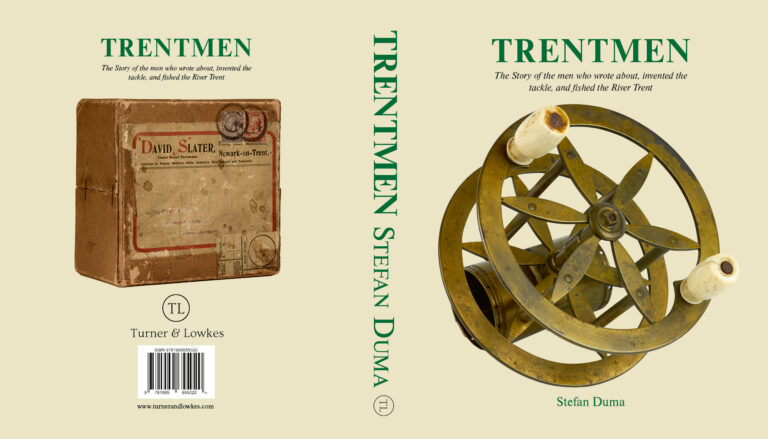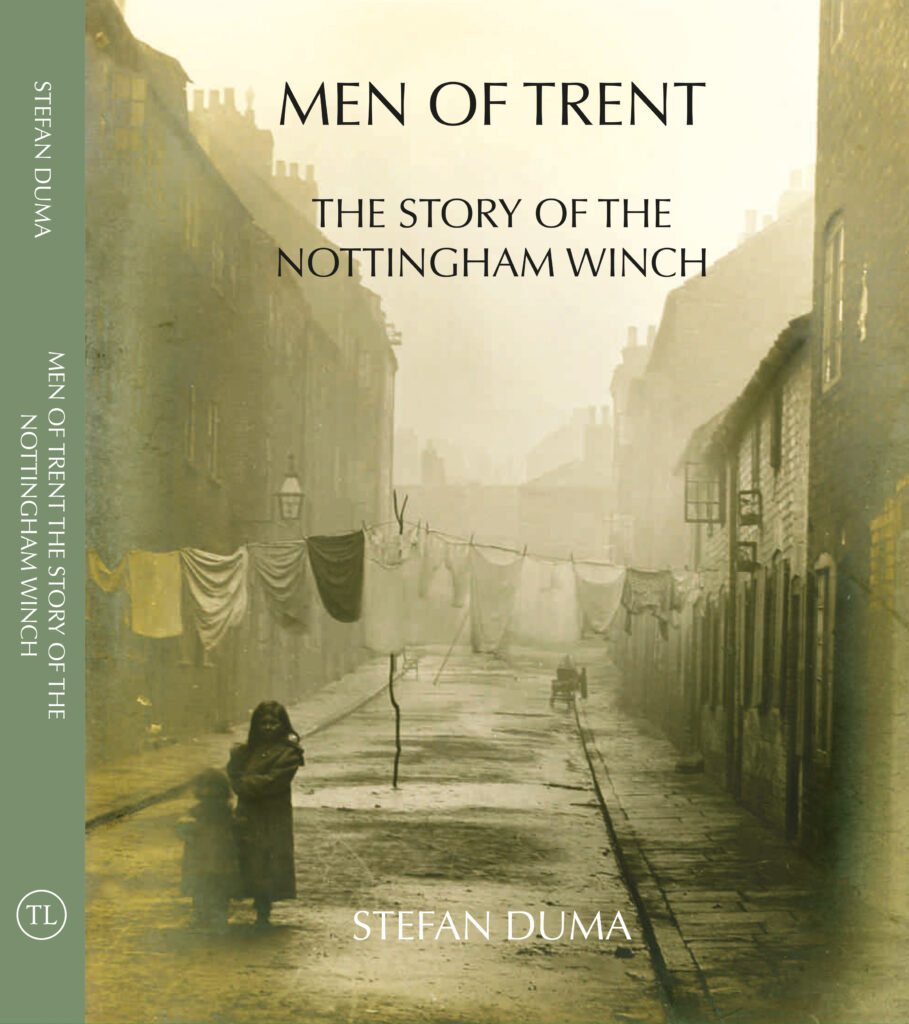

Standard edition £110.00
Deluxe edition £150.00
As per the standard edition plus.
Head and Tail bindings
Ribbon marker
Eight facsimile David Slater Cheques for additional book marks
Loose page reel part breakdown
Slipcase
Testimonials
“In 45 years of tackle collecting this is without doubt the best book ever written, detailed research, wonderful photography and a work of art”
“WOW”
“A brilliant book”
“It’s a super book for any serious collector of vintage fishing tackle”
“it really is a work of art.”
“What a book, truly epic’’
“This is the book I have been wanting for decades’’
“Outstanding’’
“And what a book!”

Back cover A David Slater Posting box March 1913
Front cover A William Dann clamp winch Nottingham circa 1815
There will be a limited edition of 50 books, in a slipcase issued end of June 2025.
CONTENTS
PAGE
CONTENTS
Chapter 1 Men of Trent.
This chapter picks up on the previous book Men of Trent introducing the reader the book and the background information that has led to Trentmen.
Chapter 2 William Dann.
William Dann featured in Men of Trent, but the emergence of a few other Dann reels has led to a complete re-evaluation of him as a reel maker and his influence on the future of reel making in the early years of the 19th century.
This chapter will feature several newly identified reels and points to look out for.
Chapter 3 William Bailey – His Heirs, Successors and Disciples.
William Bailey writer of the very first book on fishing in the Nottingham style had two sons involved in fishing, William and John, but he had started a revolution in the way that people fished and the way that people wrote about fishing. After Bailey, a lack of formal education when writing and describing fishing was sometimes seen as an asset because they “told it like it was.”
Chapter 4 JW Martin – The Trent Otter.
John William Martin was born on 8th February 1852 at Donington Lincolnshire, the first child of James and Ann Martin. As a prolific writer of angling books, he is held in high esteem by many traditional fishermen, many longing for a way of life and style of angling that is fast disappearing. It will explore his many arguments and disagreements during his life and reveal the true story of his tragic death.
Chapter 5 Henry Coxon.
Henry Coxon, also called Harry, was born on 12th August 1849 in Lenton, Nottingham. Like many in Nottingham, his father, James, was involved in the lace industry. Over the years, there have been many words written about Coxon, his occupation, his exploration and the opening of the fishing on the Hampshire Avon; the “guardian of the Nottingham Style and Traditions” and the invention of the Coxon Aerial.
Chapter 6 William Henry Dingley.
William Henry Dingley was born on 16th July 1860 in Coventry, Warwickshire, and there have, over the years, been many words written about him. My intention is not to cover this previously recorded ground in detail but to concentrate on the period he spent working for Slater in Newark on Trent and the effect that this had on his future reel- making.
This chapter will identify the reels he made at Heaton, the skills he took with him to Slater’s, and the reason he left Slater to work for Hardy Brothers, the Dingley reels made for Hardy’s and the centrepins reels he made under his own company.
Chapter 7 Wilkinson & Gumsley.
Alfred Rouston Gumsley was apprenticed to David Slater as a fishing reel maker and eventually joined Henry Wilkinson to form Wilkinson and Gumsley. Henry Wilkinson was a wood turner, ideally suited to turn wood for rods and reels. However, in many parts of the country where tackle-making took place, employers left and started on their own, in competition with their former employees. Wilkinson & Gumsley were no different.
Chapter 8 FWK Wallis.
Fredrick William Knowles Wallis was born in 1861 and died in 1959, aged ninety-eight, and was undoubtedly the greatest angler of his time.
He was not only an exceptional angler but excelled as a tournament caster and even had a cast named after him- The Wallis Cast. Wallis endorsed reels and examples made by Slater and Hardy are examined.
Chapter 9 William Nightingale.
The first time I saw a centre pin reel with nickel silver rims and coins inserted, I was intrigued, thinking it was a well-made reel by an accomplished amateur. Over the years, I saw a couple more; no one could tell me who made them or when, where, or who.
Someone told me they were Victorian because they had silver threepenny bits inserted in them with Victorian dates on them. One day a friend living near Derby called me and asked if I was interested in buying a William Nightingale reel. I told him I had never heard of the maker, and he described it. It was a “coin” reel.
This will tell the extraordinary story of a man born in Sneinton Nottingham who moved to Derby and the secret he thought he had taken to his grave.
Chapter 10 Aftermath.
My grandfather was born in the same street that I was in Sneinton, not far from Pomfret Street, where the idea of the Nottingham Centre was conceived. He was a passionate angler, and weekends were for fishing. It cost him his marriage, and he moved back to Sneinton with his daughters to live with his parents. He continued to fish and shop at Tom Watson’s.
When he remarried, he moved to Stapleford, Nottinghamshire, not far from Stanton Ironworks. He told me about a man who made Nottingham Centrepin reels at the Ironworks. That man was Harry Reynolds, an engineer who started making reels in 1938.
Chapter 11.1 David Slater.
David Slater was one of the most significant figures in the history and development of fishing tackle, with two of his inventions still in use today. He was a renowned angler in aspects of the sport, a shooter, a member of the South Notts Yeomanry Band, a counsellor, and a property developer. He instigated the setting up of the local angling society that prominently promoted and discussed the introduction of the close season with the Fresh Waters Fisheries Act of 1878.
Chapter 11.2 The Reels.
Looks at the development of his reels, and identifies the component parts with a guide to help differentiate Malloch Heaton and Smith & Wall reels.
The combination reels are examined in great detail with many examples.
Chapter 11.3 Slater – Reels.
This chapter shows and explains the reels that were not out and out combinations but could be used for specific types of fishing. Also reels that developed into models based on the combination reel.
Chapter 11.4 Slater – Fly-Reels.
Specifically covering the SEJ Flyfishers Winch and the Dry fly Reel.
Chapter 11.5 Slater – Zephyr Reels.
This chapter concentrates on the eponymous reel copied by many other manufacturers and shows its very early development and the variations we encounter.
Chapter 11.6 Slater – Hardy Reels.
One of the many companies that Slater manufactured reel for were Hardy Brothers and this chapter will highlight the close relationship they had with each other.
Chapter 11.7 Slater – Marston-Crossle Reels.
Slater had a close working relationship with Milward that would eventually lead to Milward buying the company from Charles Smith and making reels in Newark-on-Trent until the mid 1930’s. The first Crossle reels were made in Newark and eventually the Marston-Crossle reel were made there.
Chapter 11.8 Slater – Mahseer, Harling and Sea Reels.
This chapter will cover the specialist sea reels that would be adapted for Mahseer fishing by members of the British Raj. It was used by Scottish and Norwegian anglers for Harling or Trolling on the big rivers of their countries.
Chapter 11.9 Slater – Bernard and other retailers’ Reels.
Bernard and Slater had first met at the International Fisheries Exhibition in 1883 and would form a close working relationship for more than twenty years. At one time the majority of the reels in the Bernard catalogues were made by Slater. He also made reels for other retailers some can be seen in old catalogues but have still to surface.
Index.
1
25
45
61
85
111
159
187
197
243
249
299
373
443
451
479
493
505
545
593
Other titles available.


When most people think of Nottingham reels, they immediately associate them with the cheap wooden ones found on various online auction sites: overvalued, overhyped and underwhelming in their appearance. These are the run-of-the-mill Nottingham reels from the late 1800s to the early 1900s. However, there are others: beautiful works of art that preceded these potboilers, seldom seen and not really understood.
This book will explain the reasons why they were made in Nottingham and not elsewhere. Starting with reels from the early 1800s, the reader will see the biggest collection of iron-pillared clamp winches ever, along with possibly the earliest centre winch to surface so far.
Lavishly illustrated with more than 100 full-colour photographs detailing how the reels were made and their variations, it will pinpoint not only the date of the invention of the spring latch but for the first time, identify the individual behind it.
This book makes everything that has so far been written on the Nottingham winch either obsolete or incorrect.
Many people have heard of Percy Wadham and his lures, some even think that he made a few reels, but most people are unaware of the contribution of Percy Scott and his role in the company. How did a brilliant engineer and an outstanding marketer team up, inventing and manufacturing fishing reels and hundreds of other items of fishing tackle?
This book will tell the story of the Dreadnought Casting Reel Co. which only existed for just over 10 years, it will set the scene starting in the dying days of the Victorian era moving through to the Edwardian period when casting tournaments were all the rage.
With the start of WW1, there were changes and we still do not know the full extent of the contribution that the two men made towards the war effort; a grenade launcher, a collapsible armchair that would fit in a submarine and also act as a flotation device and eel traps designed to help overcome the food shortages.
This volume will explain the various reel models along with accurate dating and naming of the reels. Lavishly illustrated with more than a hundred full colour photographs of the reels showing the variations and progression of each model. It will look into the legal battle the two men had with Hardy Brothers and could it uncover the real reason Dingley left Hardy Brothers.